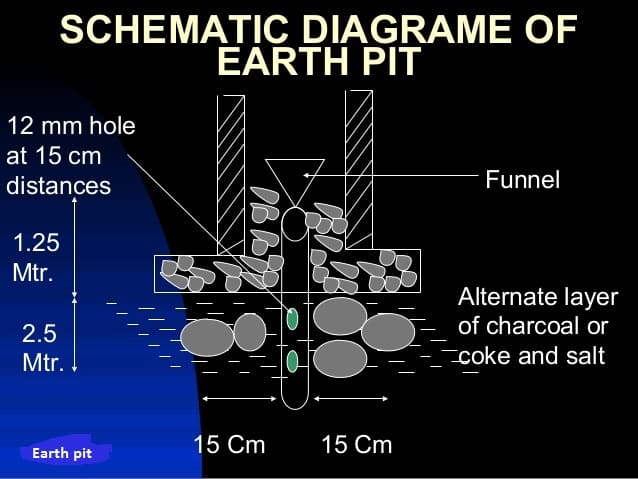Salt and charcoal increase the conductivity of the soil in the earth pit. As a result, the fault current finds an easy path through equipment to the earth. The alternate layers of charcoal and salt maintain low resistance to earth fault currents.
Adding charcoal, salt, and water to the earthing pit decreases soil resistivity.
We use conventional pipe and plate earthing for earthing purposes. Two types of material are used to fill the earth pit.
- Salt
- Charcoal

Before understanding the concept behind using salt and charcoal for earth pits, let’s first understand the properties of these materials.
Earthing Pit Materials
Charcoal
The wood, other plants, and animal materials are volatile and can be burned. We can easily remove all water and volatile constituents by strongly heating these materials. After removing water & volatile contents, the black carbon residuals are left, known as charcoal.

The properties of charcoal are,
- It is a porous material.
- Absorbs moisture from the air- Hygroscopic
- charcoal is an allotrope of carbon and acts as a conductor of electricity
Salt
It is an ionic compound. It has a strong attraction for polar water molecules. Thus, the salt absorbs moisture from the soil and keeps the earth pit moist.

The charcoal and salt perfectly make the ionic bonding with moisture in the soil. Thus, the water content in the earth pit increases. The moisture increases the conductivity of the earth pit.
The earth resistance of the earthing pit is the combined resistance of the earth pit and the surrounding soil. The soil conductivity differs with the types of soil. Therefore, it is a must to check the conductivity of the soil before making an earth pit.
Why are salt and charcoal used in earth pits?
- The charcoal and soil both absorb the moisture from the soil. The salt can bond well with charcoal, soil, and water. Thus, both materials used in the earth pit increase its conductivity.
- Charcoal and coal can retain the absorbed moisture for a more extended period.
- Salt and charcoal minimize the earth pit resistance. Thus, it provides the least resistance path to the fault current.
- The low-value earth resistance leads to easier passing of the fault current to the ground. Thus, it protects machines and humans.
Maintenance of Earthing Pit
We must take the following steps to ensure the healthiness of the earth pit.
- Measure the earth pit resistance on the driest day once a year.
- Record the resistance
- If resistance is high, take necessary action to lower the resistance by watering the pit.
- Again, measure the resistance.
- If resistance is OK, no action is required.
- If resistance is not OK, discard the earth pit.
- Salt and Charcoal have leaching properties. It means these materials washed away after some time. Therefore, periodic checking and maintenance are a must for its health.
The high resistance of the earth pit may cause serious accidents because the step voltage and touch potential increase with an increase in the earth’s resistance. Therefore, it is of utmost importance to keep the earth pit resistance as low as possible.
We can perform the soil treatment to lower the resistance as per the IEEE80-2013 standard.
What is the ratio of salt and charcoal in Earthing?
A ratio of 3:1 of charcoal and salt is good for earthing pit.
Which material is used in earthing pit to get 0.5 ohms value at rocky area
I would like to know how many rings can be coiled in an electrical wire mat, e.g in a spider wire mat?
And also how can one measure the strength of earthing, how do you measure it, I mean where do one connect the multi meter in order to measure it?
What, in kg, is the required weight of salt to be put on an electrical earthing pit and also what could be the amount of charcoal, in kg, to be put on an electrical earthing?